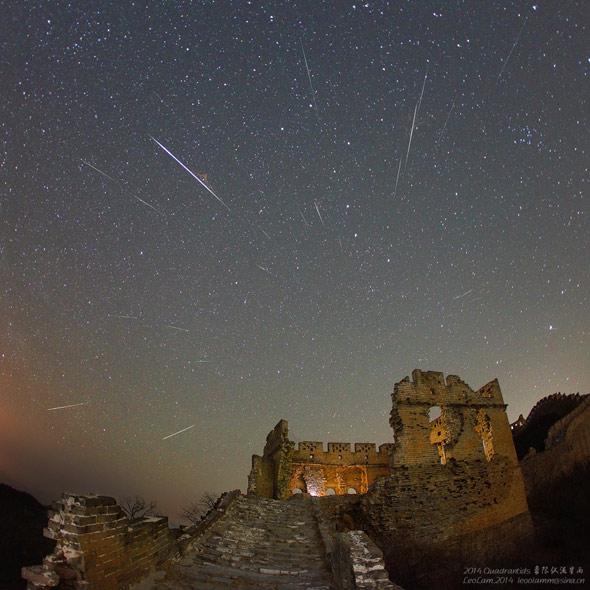The Quadrantid meteor shower peaked last week on Jan. 3. The Earth plowed through the debris left behind by the asteroid 2003 EH, creating thousands of shooting stars in the sky. Most debris trails are left by comets and are pretty wide, which means the showers can last for days. The Quadrantid source trail, though, is really narrow, which means the number of meteors in the Quadrantids peaks very sharply, essentially going from nothing to 120 meteors per hour to nothing again in less than a day.
Unfortunately for those of us in America, we had our backs turned to last week’s show; our side of the planet was facing the Sun, and we missed it. But folks on the other half of the world got a fine show indeed. Apparently, the viewing was excellent in China … because photographer Leo Lamm took this truly magnificent picture of the stream as cosmic debris rained down on Earth over the Great Wall:

Photo by Leo Lamm, used with permission
Now that’s a great photo! It’s a composite of many 40-second exposures, put together to correct for the motion of the stars as the Earth rotates (otherwise you’d see them as arcing trails). Twenty-eight meteors appear in this picture, including some that left visible vapor trails that blew around in the upper-atmospheric winds, 100 kilometers above the ground. You can see those as red smears; the brightest meteor left the most obvious one. The technical term for these is persistent trails, and they sometimes last for several minutes.
Besides the beautiful setting and composition of Lamm’s photo, I love it because it shows an important aspect of meteor showers: They appear to streak in from a single spot in the sky, called the radiant. That’s a perspective effect, similar to raindrops appearing to come from ahead of you when you drive through a rain shower. Meteor showers are named after the constellation in which their radiants lie, and the Quadrantids are named after the constellation Quadrans Muralis, which no longer exists! The constellations of Boötes, Ursa Major, and Draco now cover that part of the sky. Constellations are just made-up boundaries, like state borders, and were made official in 1930.
To make this more clear, I annotated Lamm’s photo:
There you can see the stars in the Big Dipper (part of Ursa Major), and the lines marking Polaris, the pole star. The radiant of the shower is below the tail/handle of the dipper. Off to the right, can you see the wishbone-shaped collection of stars? That’s the Coma Berenices Cluster, also called Melotte 111. It’s an actual cluster of stars about 300 light years away, which is close enough that they appear spread out in the sky. It’s easy to spot from a dark site and fun to look at through binoculars. This time of year it’s up around midnight, if you’re curious and want to take a look.
Judging from the stars’ positions, Lamm took this photo well after midnight, probably around 1 or so in the morning, not too far from the peak. No wonder he saw so many meteors! Next year, the shower peaks again on Jan. 3, but I haven’t seen a reliable prediction for the time of day. Unfortunately, the nearly full Moon will be up all night for that date, so I doubt it’ll be great viewing. Happily, though, lots of other showers should perform well this year. I’ll be sure to let y’all know when a good one is coming, and don’t forget to check Universe Today’s 2014 Sky Calendar to see what else there is to see above your head in the coming year.
Tip o’ the Whipple Shield to FlickrMeteors via EpicCosmos.